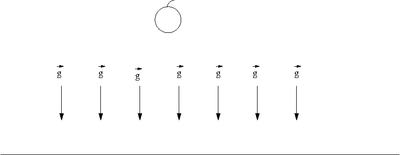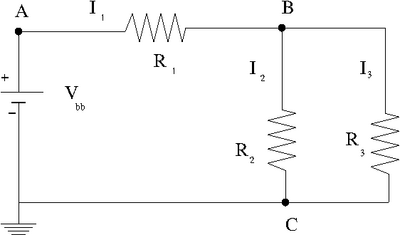Difference between revisions of "TF EIM Chapt1"
| Line 53: | Line 53: | ||
Where G= gravitational constant = <math>6.67 \times 10^{-11} \frac{N m^2}{kg^2}</math> | Where G= gravitational constant = <math>6.67 \times 10^{-11} \frac{N m^2}{kg^2}</math> | ||
| + | |||
| + | |||
| + | ===Electric Field Vector=== | ||
| + | |||
| + | Instead of an apple of mass <math>(m)</math> we can use a test charge of charge <math>(q_0)</math>. | ||
| + | |||
| + | Instead an earth of mass <math>(M)</math> we can use an object of charge <math>(Q)</math>. | ||
| + | |||
| + | We now define an Electric field Vector <math>(\vec{E})</math> such that | ||
| + | |||
| + | :<math>\vec{E} = \frac{F_q}{q_0} = \frac{\frac{1}{4 \pi \varepsilon_o} \frac{Qq_) \vec{r}}{r^3}}{q_0}</math> | ||
==Electric potential== | ==Electric potential== | ||
Revision as of 18:11, 3 January 2011
Fundamentals
Charge
Every stable and independent object (particle) that has charge has been observed to contain a quantized unit of charge which is a multiple of
What are the obervations/experiments?
Experiment 1: Matter is composed of Atoms with a positively charged nucleus surround by negatively charged electrons. If we now the charge of one mole of electrons (= Faradays constant) and the number of electrons in a mole ( = Avagadros number)then the charge of a single electron is given by
Experiment 2: Oil drop experiment
Experiment 3: The Hall Effect and the Josephson Effect
- Coulomb
- The amount of charge that flows through any cross section of a wire in 1 second if there is a steady current of 1 ampere in the wire.
Coulomb Force
Two charged object separated by a distance (d) will feel a force between them known as the coulomb force. The magnitude of this force has been experimentally shown to be
where
- F/m = a experimentally measured quantity satisfying the above relationship know as the permittivity of free space.
- charge of first object
- charge of second object
- distance between the charges
(Charles Augustin Coulomb first measured the attract and repulsive force between two charged objects using a torsion balance around 1785)
This force may be described in terms of an electric field E such that
Where
- F= force between the objects
Electric Field
Vector Field
- What is a vector field?
- A vector field is the association of each point in space with a direction (vector).
Example: Gravity. On the surface of the earth you observe that an apple will fall down to the ground. You can measure the magnitude of this force by observing the attraction much like how coulomb observed how two charges attract or repel each other. You can define a vector ( which points directly down and tell you the direction that an apple will accelerate if it is released. If you construct such that
- = acceleration of an apple towards the earth's surface when close to the earth's surface.
Where G= gravitational constant =
Electric Field Vector
Instead of an apple of mass we can use a test charge of charge .
Instead an earth of mass we can use an object of charge .
We now define an Electric field Vector such that
Electric potential
Ohm's Law
- resistance is a constant
- = constant
Voltage
The MKS unit for Voltage is a Joule per Coulomb
Voltage in circuits is typically defined as the electric potential energy per unit charge relative to ground.

